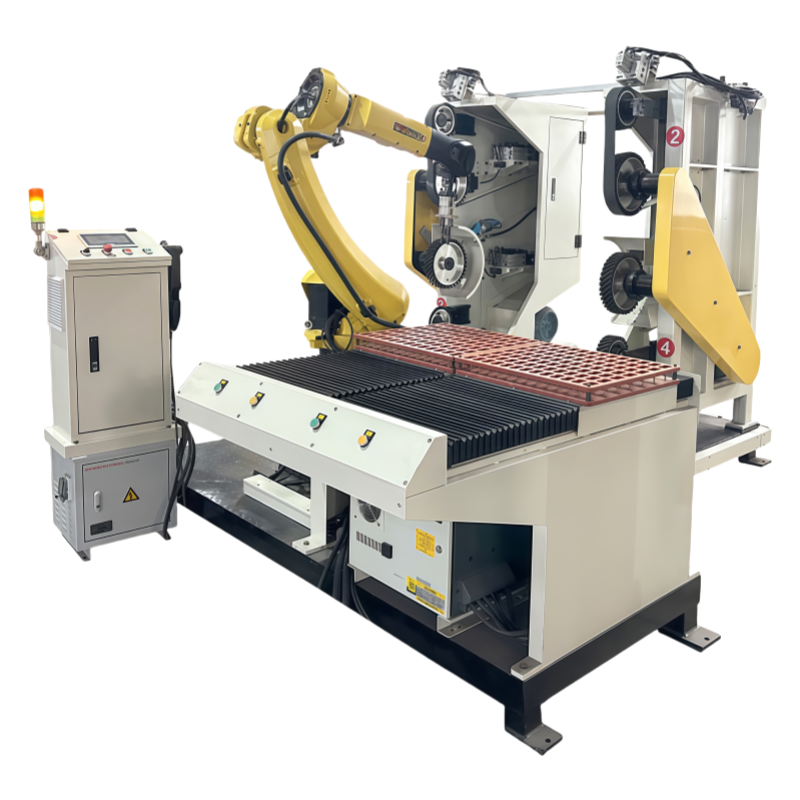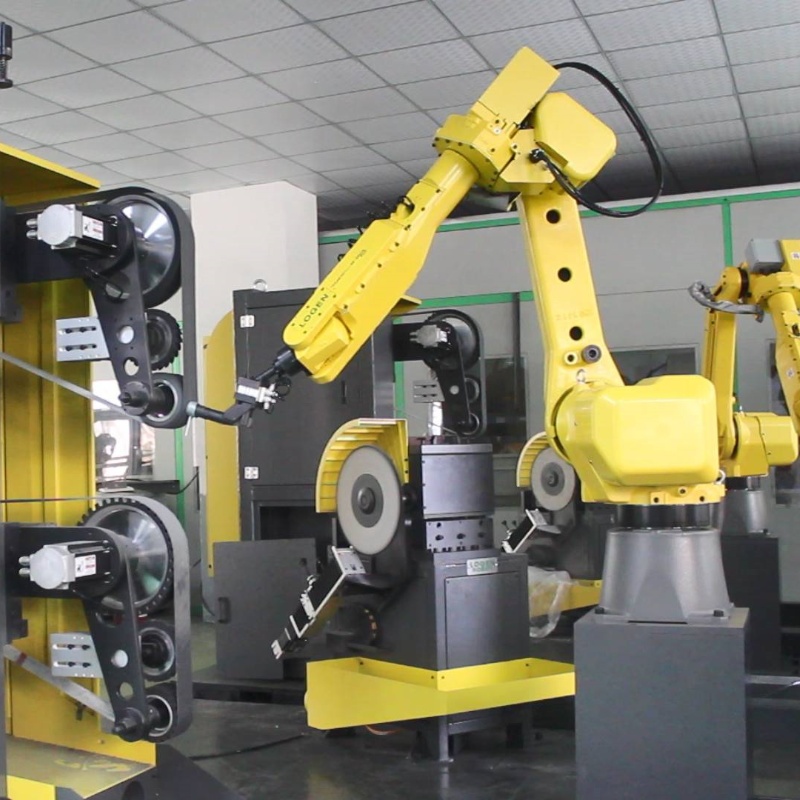Robotic Cell for Belt Grinding, Polishing, and Brightening Sanitary Faucet Bodies and Bathroom Fittings
The Robotic Cell for Belt Grinding, Polishing, and Brightening Sanitary Faucet Bodies and Bathroom Fittings is a state-of-the-art automated system designed to handle the complete surface finishing process for complex, high-precision bathroom fittings and sanitary faucet bodies. This robotic cell integrates advanced robotic technology, belt grinding, and polishing systems to deliver exceptional surface quality on components such as faucets, bathroom fittings, faucet handles, shower heads, and other metal-based products. Combining grinding, polishing, and brightening functions, this robotic cell streamlines production while maintaining consistent, high-quality finishes.
This system is particularly well-suited for manufacturers looking to improve production efficiency, reduce labor costs, and achieve superior surface finishes on parts made from materials such as brass, stainless steel, and copper. The robotic cell can process various geometries, from simple to complex shapes, making it a versatile solution for a wide range of parts within the sanitary fitting and hardware industries.

Key Features and Benefits
Robotic Technology for Precision and Flexibility
The robotic arm at the core of this system provides precision, flexibility, and repeatability that are critical when processing parts with intricate shapes. The robot is equipped with advanced motion control systems that allow for multi-axis operations, ensuring that even the most complex surfaces receive consistent treatment. The ability to program the robot to handle various operations, such as grinding, polishing, and brightening, ensures that it can process a wide variety of components without manual intervention.
The robotic system allows for precise control over the belt grinding and polishing process, ensuring optimal material removal and surface finish consistency. It is designed to handle parts with delicate features, including threads, edges, and curves, making it ideal for products like sanitary faucet bodies, faucet handles, and shower heads that require a uniform and high-quality finish across all surfaces.
Belt Grinding and Polishing
This robotic cell integrates belt grinding and polishing technology to handle various stages of surface finishing. The belt grinding station removes rough edges, burrs, and oxidation from the surfaces of the parts, preparing them for a smooth and uniform finish. The polishing stage follows, ensuring that the component achieves a high-gloss, mirror-like finish, often required in bathroom fixtures and other sanitary fittings.
Belt grinding is a highly effective technique for efficiently removing material from the workpiece, especially when dealing with castings or parts that have rough surfaces. The abrasive belts are available in various grits, allowing manufacturers to choose the appropriate level of aggressiveness for each application.
The polishing process, on the other hand, is designed to bring out the high-shine appearance that is characteristic of high-end bathroom and kitchen fittings. The robotic arm handles the polishing mops, ensuring uniformity and avoiding variations that often occur with manual processes. The result is a consistent and flawless surface brightness on the faucet bodies and other fittings.
Brightening Process
The brightening function is a key aspect of this robotic cell, especially for sanitary faucets, bathroom fittings, and hardware components that require a visually appealing finish. After the grinding and polishing stages, the robotic cell applies a brightening process that enhances the surface’s reflectivity, creating a mirror-like appearance on parts made from materials such as brass, stainless steel, or chrome-plated metals.
This stage removes any residual dullness or discoloration left over from the previous operations, leaving behind a clean, bright, and lustrous surface. The brightening stage is essential in industries where aesthetics and surface quality are paramount, such as in luxury faucet manufacturing and high-end bathroom fittings.
Simultaneous Processing of Multiple Parts
The robotic polishing and grinding cell can process multiple parts simultaneously, significantly increasing production throughput. The ability to handle multiple parts in a single cycle reduces the amount of time required to complete each process, ensuring that the system remains efficient and cost-effective. This simultaneous processing capability is particularly useful for batch production, where manufacturers need to polish and grind large quantities of parts in a short period.
For example, the robotic cell can handle up to four parts in one cycle, streamlining the workflow and improving operational efficiency. This is especially beneficial for manufacturers with high-volume production needs, as it reduces the amount of time spent on each batch and ensures that all components receive the same consistent treatment.
Automated Surface Finishing
The integration of automation in the grinding, polishing, and brightening processes ensures that each component receives consistent, high-quality surface finishing every time. The system is capable of executing precise and repeatable polishing routines with minimal human intervention. By eliminating manual polishing and grinding processes, this robotic cell offers significant improvements in accuracy, repeatability, and productivity.
This automation also helps minimize human errors and inconsistencies, leading to a more reliable and predictable production output. As a result, manufacturers can confidently produce high-quality parts with uniform surface finishes across all units, ensuring that every faucet body or bathroom fitting meets the strictest quality standards.
Adaptability to Complex Geometries
One of the major advantages of the robotic polishing and grinding cell is its ability to process parts with complex geometries. Unlike traditional systems that may struggle with irregularly shaped or intricate parts, this robotic system can adapt to a wide variety of shapes and sizes, including those with curves, threads, or multiple contours.
Whether it's a faucet handle with intricate detailing or a bathroom fitting with complex angles, the robotic arm ensures that the polishing and grinding process is applied precisely to all areas of the part. This flexibility makes the robotic cell suitable for a wide range of products in the sanitary fittings industry, from simple, mass-produced components to highly customized, complex pieces.
Advanced Control and Programming
The robotic cell features advanced control systems and user-friendly programming interfaces that allow operators to easily set up and manage the system. The programming system provides flexibility in defining the polishing and grinding parameters, allowing manufacturers to create custom programs for different products or finishes. The system can also be reprogrammed quickly to switch between different types of parts or finishes, providing manufacturers with flexible production capabilities.
Furthermore, the robotic system is equipped with safety features that ensure smooth and safe operation, including collision detection, emergency stop functions, and automated error detection. This reduces the risk of accidents and ensures that the robotic polishing system operates reliably and efficiently.
Cost Efficiency and Reduced Labor
By automating the grinding, polishing, and brightening processes, the robotic cell reduces the need for manual labor, cutting down on labor costs and the risk of human error. It also improves overall production speed, allowing manufacturers to process large volumes of parts more quickly. The reduced cycle time combined with minimal waste results in a more cost-efficient operation, which is a key consideration for manufacturers aiming to remain competitive in today’s market.
Moreover, the reduction in manual labor helps eliminate the potential for inconsistencies and defects that can arise from human error, ensuring that each part receives the same level of quality treatment.
Applications and Industries
This robotic cell is designed for use in the following industries:
Sanitary Fittings and Bathroom AccessoriesThe grinding, polishing, and brightening functions are particularly valuable in the production of sanitary faucets, bathroom fittings, and faucet handles. The system ensures that all components meet the highest standards for both surface aesthetics and functional performance. Whether it's for luxury faucets or durable, everyday bathroom fittings, this robotic cell is built to meet the diverse needs of the bathroom accessories industry.
Home and Commercial Hardware ManufacturingThe robotic cell is also well-suited for the production of door handles, knobs, and other home hardware components, particularly those made from metals that require polishing or brightening to achieve a premium finish.
Custom and Specialized ManufacturingThe system is adaptable to various custom or low-volume productions, offering flexibility to manufacturers producing bespoke fittings or unique product runs. The ability to process a variety of materials and geometries makes this robotic polishing and grinding system ideal for specialized manufacturing projects.
Conclusion
The Robotic Cell for Belt Grinding, Polishing, and Brightening Sanitary Faucet Bodies and Bathroom Fittings offers a high-performance, automated solution for manufacturers looking to streamline production and maintain the highest standards of surface finish quality. With its robotic arm technology, belt grinding, polishing, and brightening capabilities, this system provides precise, repeatable, and efficient results for complex-shaped parts. It is a versatile solution suitable for high-volume production, with the ability to handle a wide variety of parts, including faucet bodies, bathroom fittings, and faucet handles.










